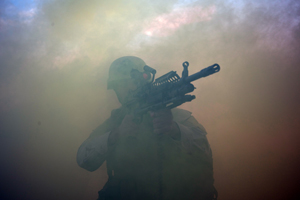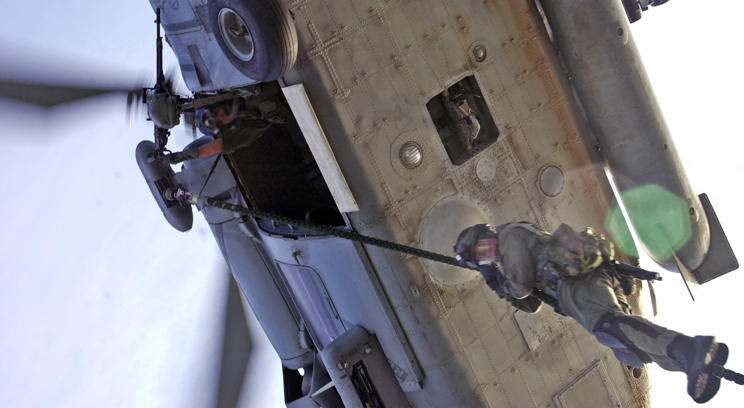For decades the MacPhail building has sat on what is now the University of St. Thomas’ Minneapolis campus and served as the home of the MacPhail Center for Music. In late-summer, the now-empty building served its country.
Slipping quietly under the publicity radar, SEALs from the Naval Special Warfare Development Group conducted training sessions in the MacPhail building on Aug. 21 and 23. The Department of the Navy, in a letter to St. Paul Mayor Chris Coleman when it was seeking permission and cooperation from local officials, described the training as “low intensity urban tactical training.”
Permission was granted and cooperation was given. The SEALs trained in the Twin Cities from Aug. 19 to Sept. 1, according to Ken McGraw of the U.S. Special Operations Command Public Affairs Office.
The training was not a classified secret, but there was little mention of it in the local media. “For our purposes, it was a routine training exercise,” McGraw remarked.

The MacPhail building, right, now sits empty on the Minneapolis campus, except for an occasional visit from a SWAT team or a Navy SEAL. (Photo by Mike Ekern)
“The thing I most closely compare it to, which most people can relate to, is SWAT training,” he added.
The MacPhail building was just one of a series of places in the Twin Cities where the unit conducted what McGraw called “realistic urban training. We conduct it frequently in major cities all over the United States – it’s just a set of skills that certain of our units maintain.”
The training included all of the basic scenarios of an urban setting, with professional role players, hostages and the breaching of doors. Mike Barrett, Public Safety’s associate director and manager of investigations, estimated that 20 to 25 doors were breached with “significant explosives” (with advance approval).
Public Safety participated in the exercise by clearing the building both Aug. 21 and 23 before the SEALs began their training.
“Because we had to keep this so quiet, we couldn’t develop our training around the SEALs’ training as much as we wanted to, but those who were involved got a ton out of the training,” said Barrett ’95, ’04 M.A., Police Leadership, Education and Administration, pointing out they were able to observe:
- How special operations units prepare for training
- Special operations training
- How special operations units maintained safety
- An high level of professionalism
- How fundamental their scenario debriefs were
- Acceptance of significant constructive criticism
- A humbleness in their approach to training
According to Barrett, the local training was first suggested by a SEAL who was from the area. The SEAL later died in a helicopter crash in Afghanistan. His fellow SEALs continued to pursue training here in memory of those who lost their lives.
Enlisting the MacPhail building for training came about through Public Safety’s relationship with the St. Paul Police Department, including Tim Flynn, commander of its SWAT team. Flynn, ’92, ’03 M.A. Police Leadership, Education and Administration, informed Barrett that “high profile” training was being planned. As Flynn revealed more, Barrett suggested using the MacPhail building “because it’s unoccupied, we don’t have certificate of occupancy, and we’ve allowed the Minneapolis SWAT team to train there before.”
It was music to the SEALs’ ears. “You could kind of see the spark, the twinkle in their eyes,” Barrett said. “They liked the building. It’s old, it’s well-put together, and it’s solidly built and can withstand pretty significant training.”

Although this is not a picture of the interior of the MacPhail building on the Minneapolis campus, one can imagine a scene much like this after the Navy SEALs were done breaching some 20 to 25 doors in the building with "significant explosives." (Department of the Navy SEAL photo.)
Buildings such as MacPhail are important because “military training sites are not sufficient to support all urban training because they lack the variety of building layouts and mass transit platforms our troops face when working in forward urban environments,” the Navy Department’s letter to Coleman noted. “Additionally, military training sites do not provide realistic urban reconnaissance and surveillance opportunities or permit our forces to work through complex navigation and planning challenges.”
Both the SEALs and Public Safety were pleased with the training that the MacPhail building afforded.
“They were extremely satisfied. They were happy with the partnership. They were happy with how willing we were to work with them – to assist them in the training,” Barrett remarked. “Believe it or not, there are some areas of the country that are less willing than the cities of Minneapolis and St. Paul were to allow this type of training.”
The SEALs’ urban training coordinator, Carlos Sandoval, wrote a letter of appreciation to Barrett, thanking him for his support. “On behalf of Naval Special Warfare Development Group, I want to personally thank you for the incredible support you gave our command during our recent training event in Saint Paul. I cannot adequately express my gratitude for your support in such a massive operation,” he wrote. “It is only through the patriotic actions of individuals like yourself that we can conduct this type of training.”
As for the MacPhail building, it remains standing; perhaps now, however, after having served its country so well, it’s more than just a musical memory – it’s also, in a sense, a memorial to America’s special operations forces who gave their lives in service to their country.







